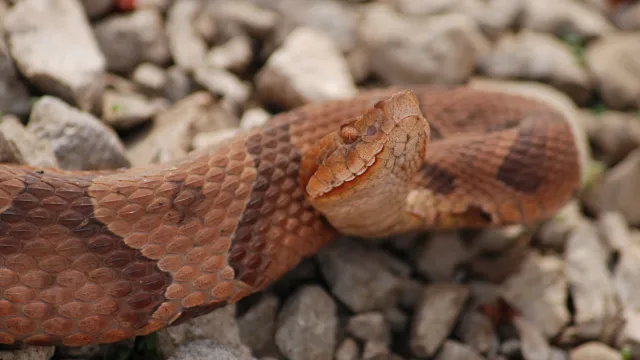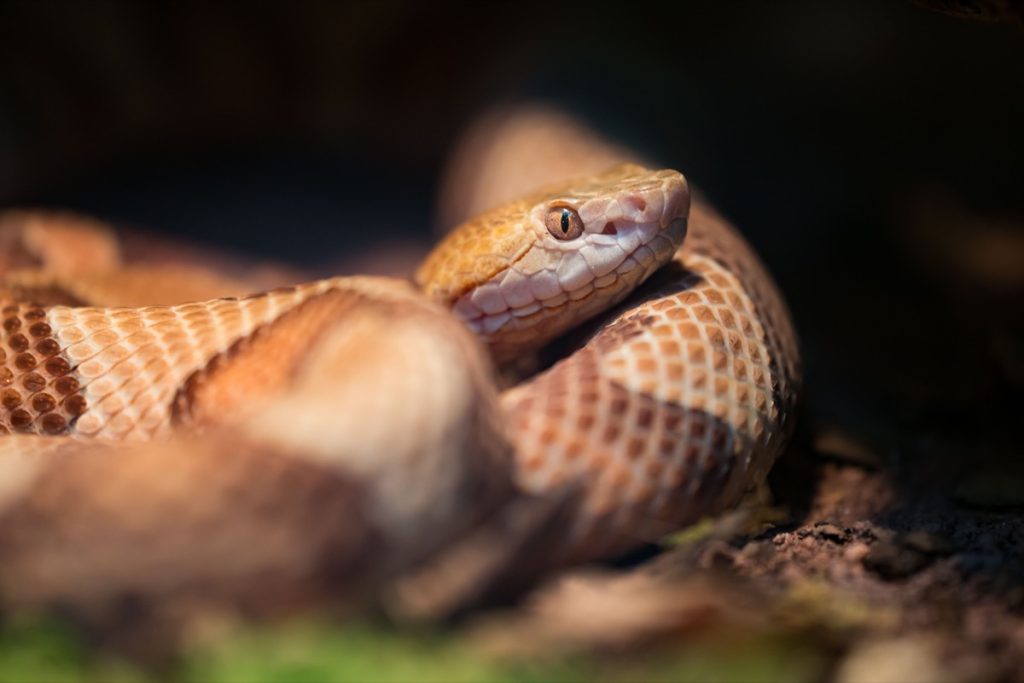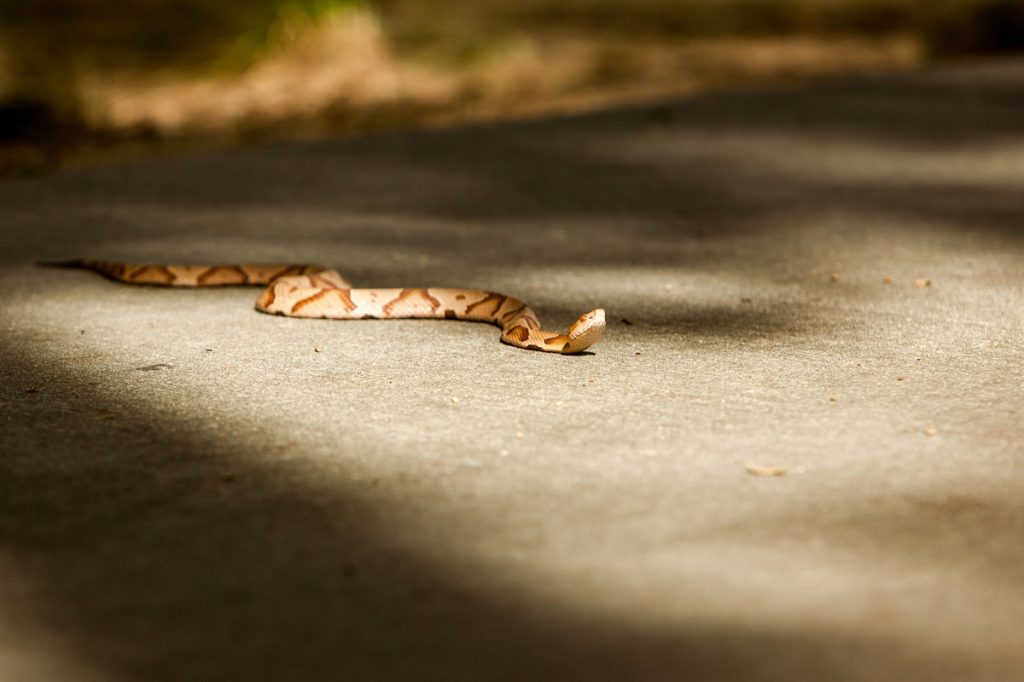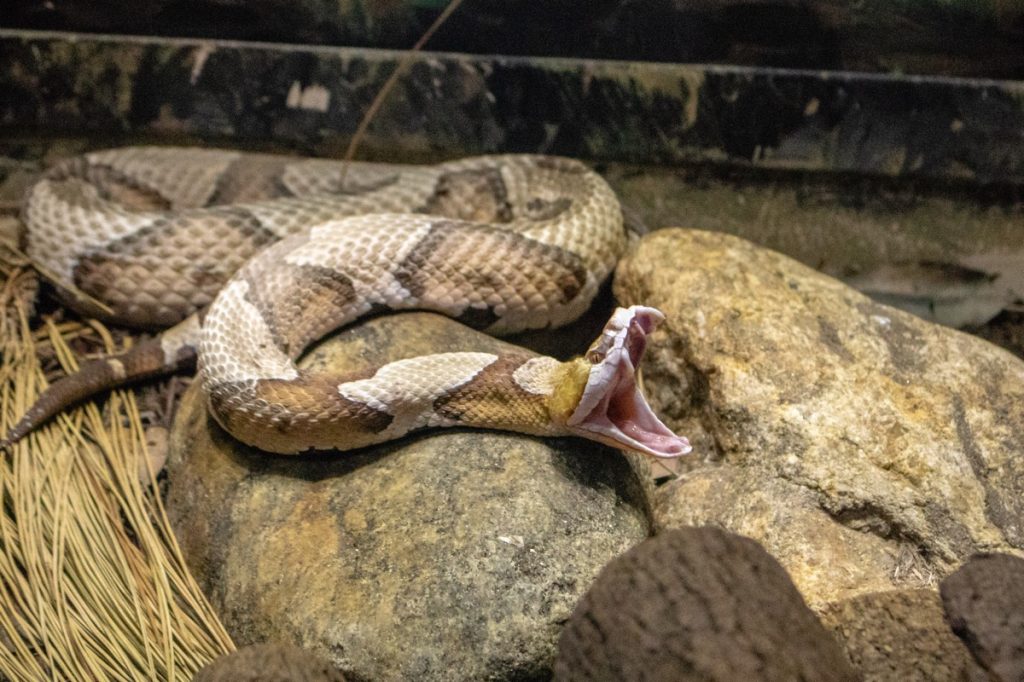Two Copperhead Bites Reported as Snake Season Begins—Here’s Where They Were Hiding

The first few warm days of spring usually bring a special kind of joy, as it finally becomes pleasant to spend time outdoors again. But we’re not the only ones who enjoy the rise in temperature: Many types of venomous snakes are also becoming more active after a long winter. These conditions make it all the more likely you’ll come across one of the reptiles while getting back into yard work or taking time to get back into nature. And now, two recently reported copperhead bites are serving as an urgent reminder that snake season is here. Read on for more information about the incidents, including where the snakes were hiding and how you can avoid them.
READ THIS NEXT: Invasive 200-Pound Pythons Are Spreading in the U.S.—And Eradication “Is Not Possible.”
One person was bitten by a copperhead after trapping it in a bucket.

We’ve all found ourselves curious about something we’ve spotted while enjoying nature. But in one recent case, an 18-year-old resident of Northaven, Tennessee wound up in the hospital after capturing a copperhead snake in his backyard with the intention of keeping it as a pet, local Memphis CBS affiliate WREG reports.
“When he came back, he had this red bucket in his hand, and I asked him what it was and he said, ‘I got a snake,'” the man’s aunt told the news outlet. “It wiggled around like it was going to bite him, so he dropped it and caught it before it hit the ground. He caught it by the tail and she come around and bit him in his index finger on his left hand.”
After calling 911, the man began to show signs of the reptile’s venom. “It was all swollen up and white, and his finger was about that big around when he went to the hospital,” she told WREG.
Despite the initially shocking symptoms, the teen managed to recover quickly. He only spent a few hours in the hospital before he was released.
Another woman accidentally disturbed a copperhead while walking her dog.

Another bite incident was reported in Tennessee around the same time by a woman making her way down a walking trail in Overton Park. In this case, the victim involved didn’t even manage to see the copperhead before it struck.
“I just was walking in the park with my dog and had moved aside to let someone pass, and must have just stepped right next to the snake and got a bite,” snakebite victim Brit McDaniel told WREG.
Unfortunately, her encounter took a bit longer to overcome. “My whole leg was swollen, a lot of pain, and I ended up with a little bit of infection too. But, once I was released I had a two-week recovery,” she said.
RELATED: For more up-to-date information, sign up for our daily newsletter.
There are a few simple ways to avoid copperhead bites.

Thanks to its expansive habitat, living in the U.S. means cohabitating with copperheads in many areas, per LiveScience. Thankfully, the snakes are not aggressive—and even play a vital role in the local ecosystem by controlling populations of common pests. But you can also cut down the chances of a surprise encounter with a snake by remembering a few simple tips.
“Common sense things like not putting your body parts into places you can’t see, not walking barefoot at night, not walking barefoot in thick vegetation, using a flashlight at night, not sticking your hands up underneath wood piles, watching what you are doing at all times, watching where you put your hands and feet will prevent the great majority of bites,” Jeff Beane, herpetology collection manager at the North Carolina Museum of Natural Science in Raleigh, told The News & Observer.
And as the teenage victim in Tennessee learned, trying to capture or touch copperheads can be the quickest way to put yourself in danger.
“Admire them from a safe distance and leave them alone,” Beane told the newspaper. “Many bites and other injuries have occurred while people were attempting to kill snakes. No one was ever bitten by a snake while they were leaving it alone.”
Here’s what you should do if you’re ever bitten by a copperhead snake.

Unfortunately, accidents can still happen even if you’re being careful to watch your step. According to the North Carolina State University Cooperative Extension Service, copperheads are responsible for more bites annually than any other type of snake, thanks in part to their large habitat.
However, most strikes aren’t a matter of life and death. Even though the elderly, young children, and immunocompromised people are at higher risk of reactions to venom, bites are “very rarely (almost never) fatal to humans,” according to Beane. Still, it’s essential to call 911 and seek medical attention if you ever wind up injured.
“Antivenom is not always required to treat a copperhead bite, but it is important to be evaluated by a physician with expertise in treating venomous snakebites in order to make that determination,” Eugenia Quackenbush, MD, an emergency physician with UNC Medical Center, told The News & Observer.
It’s also important to avoid any widely held misbeliefs around snakebite first aid. According to North Carolina Poison Control, never cut the wound, apply a tourniquet, use ice, or attempt to suck the venom out. Instead, stay calm and gently wash the area with soap and warm water while waiting for medical assistance.